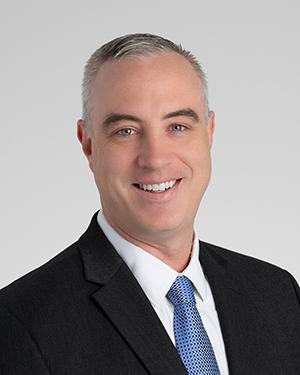Research News
02/21/2023
Building 'digital twin neighborhoods' to support public health initiatives, research
Cleveland Clinic and MetroHealth researchers to use $3.14 million NIH grant to build data models for investigating place-based healthcare gaps.

The neighborhoods with the lowest and highest life expectancy in Cuyahoga County are Woodhill and Shaker Heights, 1.1 miles away from each other, illustrated above with CDC US Small Area Life Expectancy Project (USALEEP) data.
Where a person lives or works can shape their health outcomes – including their life expectancy and risk of developing diseases like cancer or diabetes. This example rings close to home in Cleveland, where neighborhoods with the highest and lowest life expectancy rates are located just over a mile apart.
Researchers from Cleveland Clinic and MetroHealth, backed by $3.14 million from the National Institutes of Health, are using an emerging technology known as healthcare "digital twins" to study these differences and begin to offer data for creating solutions.
When addressing community public health, local organizations have an overwhelming amount of options, but limited time and money to study the individual attributes of populations. As a result, new health strategies or programs that target broad populations often miss certain groups of people, deepening these deep divides.
Enter digital twins. These sophisticated data models are built from electronic health records – data aggregated from digital versions of patient charts – to analyze health trends. Digital twins aid in accurately representing complex economic, environmental and social factors that can lead to differences in healthcare access or outcomes between neighboring communities.
"This is the biggest problem in population health of our time, and in Cleveland, it's particularly severe," says Jarrod Dalton, PhD, Director for Cleveland Clinic's Center for Populations Health Research. "It stems from decades of residential segregation and corresponding investment in communities that's had an impact on people's health and longevity."
On Cleveland's east side, the life expectancy in Woodhill is 65.4 years, according to CDC estimates. In stark comparison, the life expectancy in nearby Shaker Heights is 88.6 years, based on federal data. These two neighboring communities also differ in socioeconomic factors like education, income and occupation.
"We're committed to supporting lifelong health for our patients and the communities where they reside," says Serpil Erzurum, MD, Cleveland Clinic's Chief Research and Academic Officer. "To help us begin to address and treat the root causes of disease, we need to understand what has led us to this point. Using innovative approaches like digital twin communities is the future of population research, and it will reveal how we can make positive changes in our communities."
Supporting collaboration in public health
Dr. Dalton and Adam Perzynski, PhD, at MetroHealth's Population Health Research Institute (PHRI), are principal investigators on the grant and long-time collaborators. They are joined by Drs. Elizabeth Pfoh and Glen Taksler from the Center for Value-Based Care Research at Cleveland Clinic and Drs. Kristen Berg, Douglas Gunzler and Yasir Tarabichi from PHRI as co-investigators.
In addition to infrastructure development, the NIH grant also funds some initial projects using the tool: assessing regional mental health initiatives on a neighborhood level; evaluating the potential impacts of introducing new services on cardiovascular disease burden in communities; and evaluating how frequent and/or economically-driven relocations of residence affect health outcomes.
To address public health issues on a neighborhood level, groups can introduce education programs like anti-smoking campaigns or information on what causes heart disease. Organizations can also provide more resources like food distribution or specialized clinics. However, it's notoriously difficult to predict how these kinds of changes might influence health outcomes in specific neighborhoods.
"As a scientist, I have always wanted to lead a project that I felt was truly transformational. I feel like this is that project," Dr. Perzynski says. "It has real potential to lead community-level policies and decision-making that improves health."
Along with clinical information, electronic health records include some information on aspects of a patient's life that might influence health education and outcomes as they age. The EHR data used on this scale is deidentified, meaning that you can't tie it back to a specific person.
Drs. Dalton and Perzynski previously published a study in the Annals of Internal Medicine using electronic health records to determine if a neighborhood's socioeconomic status was tied to cardiovascular disease events like heart attack or stroke. Using electronic health records data, their team's analysis showed a close association and found that traditional risk-predicting models underpredicted the risk of a cardiovascular event in disadvantaged neighborhoods.
Evaluating technology like digital twins that use this technology in the research space can make it easier for organizations like local governments to take a data-backed approach to public health interventions. Instead of building these models from scratch, other health systems and organizations can adapt the framework for their own needs.
"These problems aren't unique to Cleveland. They exist all over the country and globe," says Dr. Dalton. "We're designing an approach to help health systems, governments and organizations collaborate to highlight place-based issues and strategize ways to fix clear gaps."
Featured Experts
News Category
Related News
Research areas
Want To Support Ground-Breaking Research at Cleveland Clinic?
Discover how you can help Cleveland Clinic save lives and continue to lead the transformation of healthcare.
Give to Cleveland Clinic